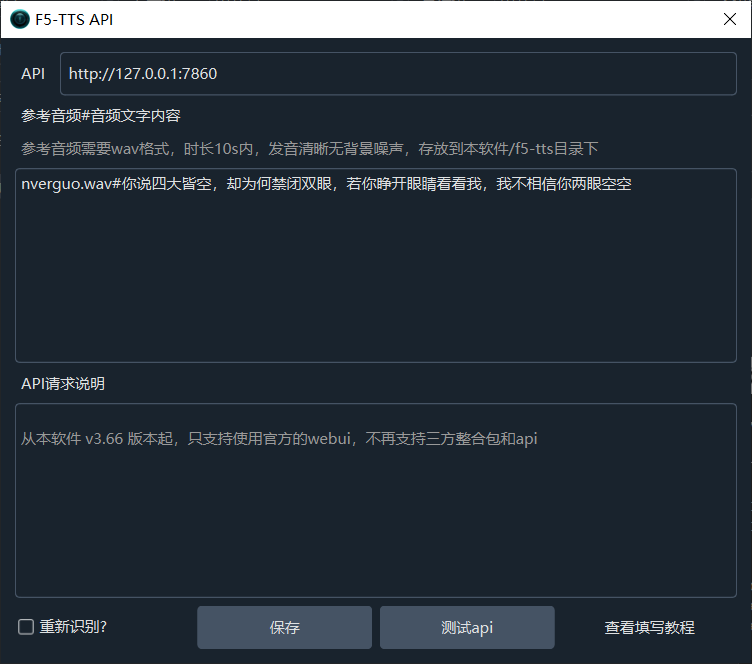Spark-TTS is a recently prominent open-source voice cloning project, jointly developed by several universities, including the Hong Kong University of Science and Technology, Northwestern Polytechnical University, and Shanghai Jiao Tong University. Local testing shows its performance is comparable to F5-TTS.
Spark-TTS supports Chinese and English voice cloning, and the installation and deployment process is not complicated. This article will detail how to install and deploy it, and modify it to be compatible with the F5-TTS API interface, so that it can be directly used in the F5-TTS dubbing channel of the pyVideoTrans software.
Prerequisites: Ensure that Python version 3.10, 3.11, or 3.12 is installed.
1. Download Spark-TTS Source Code
First, create a folder consisting of English or numbers on a non-system drive, such as D:/spark. The reason for requiring English, numbers, and a non-system drive is to avoid potential errors related to Chinese characters and permissions as much as possible.
Then, visit the official Spark-TTS code repository: https://github.com/SparkAudio/Spark-TTS
As shown in the figure below, click to download the source code ZIP package:
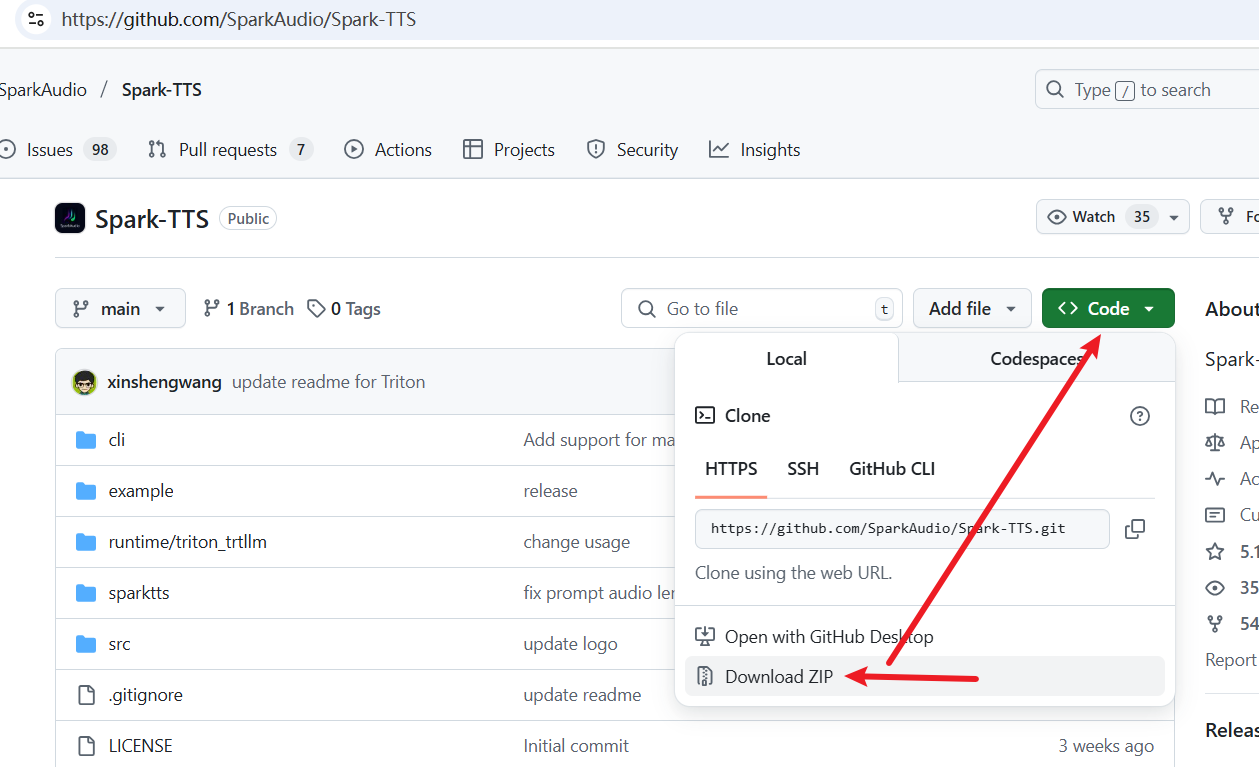
After downloading, unzip it and copy all the files and folders to the D:/spark folder. The directory structure after copying should be as shown in the following figure:
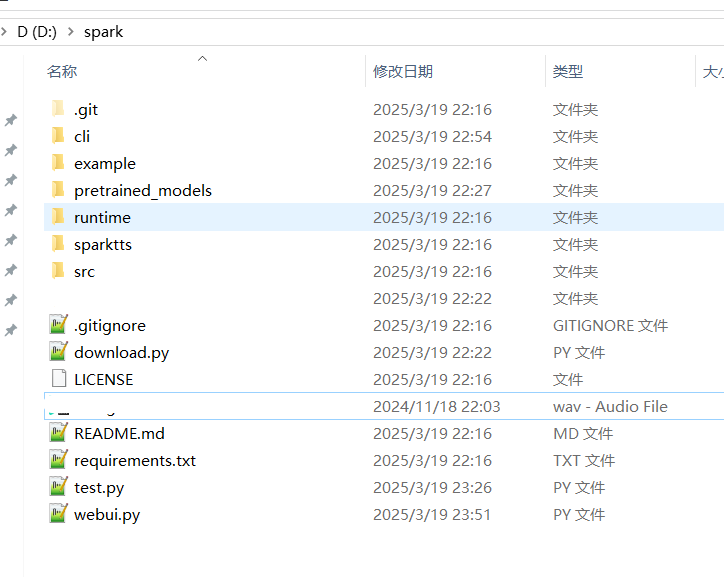
2. Create a Virtual Environment and Install Dependencies
- Create a Virtual Environment
Enter cmd in the address bar of the folder and press Enter to execute the following command in the popped-up black terminal window:
python -m venv venvAs shown:
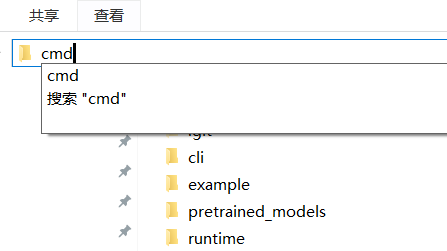

After execution, a venv folder will be added to the D:/spark directory:
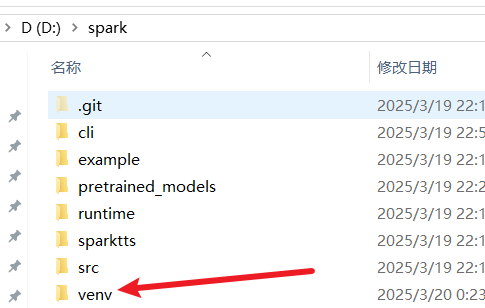
Note: If you are prompted with
python is not an internal or external commandduring execution, it means that Python is not installed or not added to the system environment variables. Please refer to the relevant articles to install Python.
Next, execute venv\scripts\activate to activate the virtual environment. After activation, (venv) will appear at the beginning of the terminal line, indicating that the activation is successful. All subsequent commands need to be executed in this environment. Please check whether it has been activated before each execution.
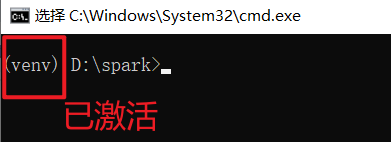
- Install Dependencies
In the activated virtual environment, continue to execute the following command in the terminal to install all dependencies:
pip install -r requirements.txtThe installation process may take a long time, please be patient.

3. Download Models
The models required for open-source AI projects are usually hosted on Hugging Face (huggingface.co). Since this website has been blocked in China, you need a VPN to download the models. Please ensure that you have configured the VPN environment and set up the system proxy.
Create a text file named down.txt in the current directory D:/spark, copy and paste the following code into the file and save it:
from huggingface_hub import snapshot_download
snapshot_download("SparkAudio/Spark-TTS-0.5B", local_dir="pretrained_models/Spark-TTS-0.5B")
print('Download complete')Then, execute the following command in the terminal window of the activated virtual environment:
python down.txtMake sure to check if (venv) exists before the command line:

Wait for the terminal to prompt that the download is complete.
If the output is similar to the following information, it means that the network connection is incorrect, and the VPN environment may not be configured correctly:
Returning existing local_dir `pretrained_models\Spark-TTS-0.5B` as remote repo cannot be accessed in `snapshot_download` ((MaxRetryError("HTTPSConnectionPool(host='huggingface.co', port=443): Max retries exceeded with url: /api/models/SparkAudio/Spark-TTS-0.5B/revision/main (Caused by ConnectTimeoutError(<urllib3.connection.HTTPSConnection object at 0x000001BC4C8A4430>, 'Connection to huggingface.co timed out. (connect timeout=None)'))"), '(Request ID: aa61d1fb-ffc7-4479-9a99-2258c1bc0aee)')).
4. Start the Web Interface
After the model is downloaded, you can start and open the Web interface.
Execute the following command in the terminal with the virtual environment activated:
python webui.py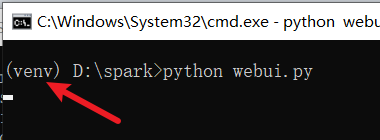
Wait for the following information to appear, indicating that the startup is complete:

At this point, you can open the address http://127.0.0.1:7860 in your browser. The Web interface is shown below:
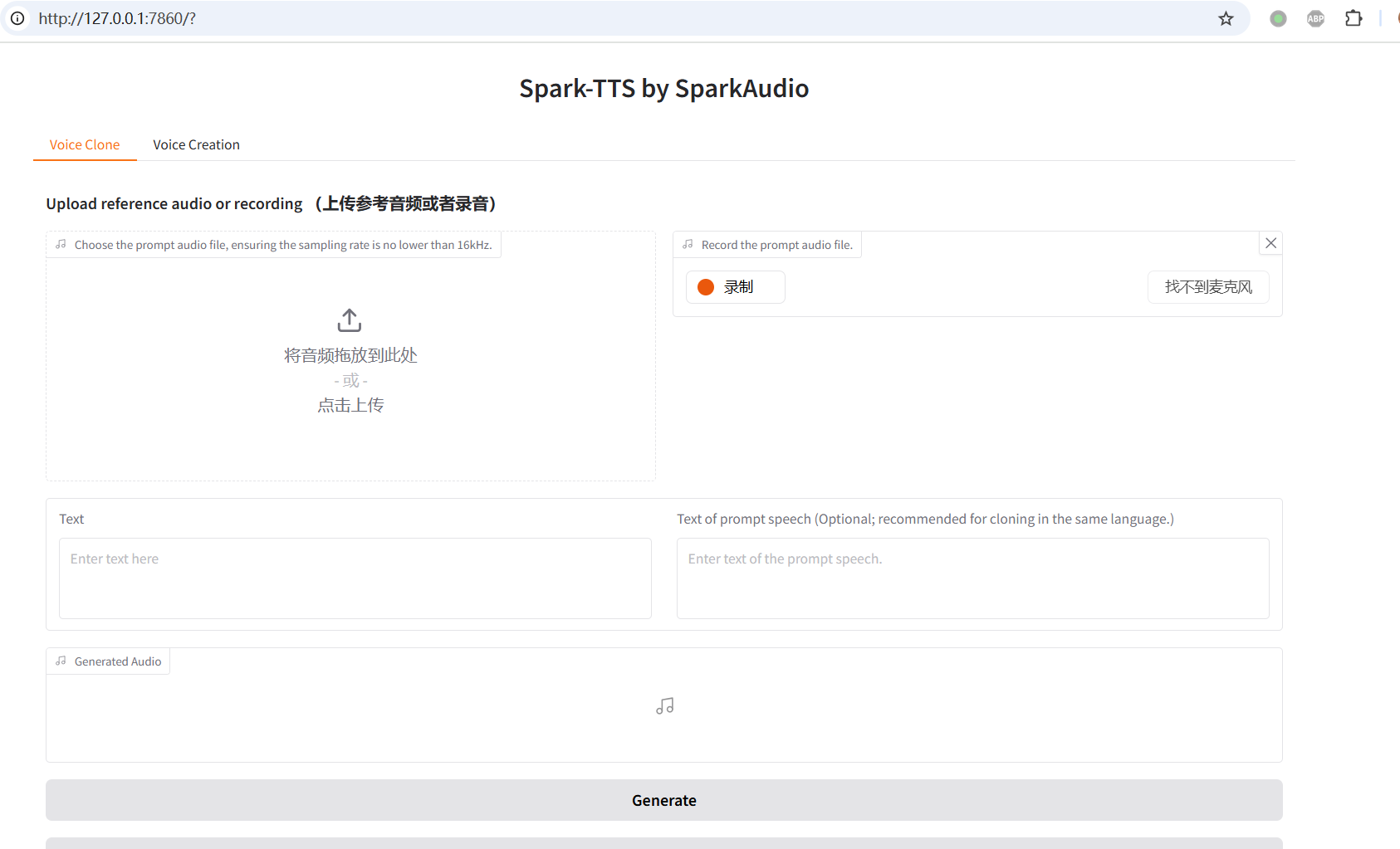
5. Voice Cloning Test
As shown in the figure below, select an audio file with the voice you want to clone (3-10 seconds in duration, clear pronunciation, clean background).
Then, enter the text corresponding to the audio in the Text of prompt speech on the right, enter the voice text you want to generate on the left, and finally click the Generate button at the bottom to start execution.

After execution, as shown below.
6. Using in pyVideotrans Software
Spark-TTS is very similar to F5-TTS. With simple modifications, Spark-TTS can be directly used in the F5-TTS dubbing channel of pyVideotrans.
- Open the
webui.pyfile, and paste the following code above line 135 (approximately):
def basic_tts(gen_text_input, ref_text_input, ref_audio_input,remove_silence=None,speed_slider=None):
"""
Gradio callback to clone voice using text and optional prompt speech.
- text: The input text to be synthesised.
- prompt_text: Additional textual info for the prompt (optional).
- prompt_wav_upload/prompt_wav_record: Audio files used as reference.
"""
prompt_speech = ref_audio_input
prompt_text_clean = None if len(ref_text_input) < 2 else ref_text_input
audio_output_path = run_tts(
gen_text_input,
model,
prompt_text=prompt_text_clean,
prompt_speech=prompt_speech
)
return audio_output_path,prompt_text_clean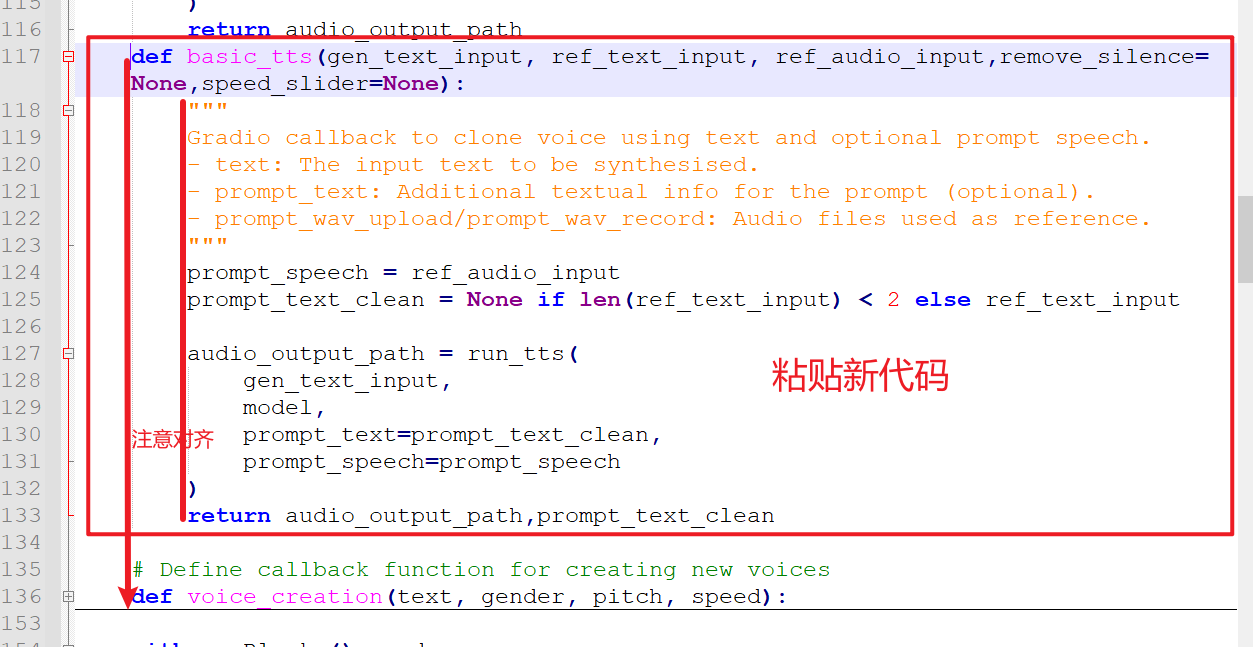
Special Note: Python code uses spaces for indentation alignment, otherwise the code will report an error. To avoid errors, it is recommended not to open the webui.py file with Notepad, but to use a professional code editor, such as Notepad++ or VSCode, etc. free tools.
- Then, find the
generate_buttom_clone = gr.Button("Generate")code around line 190. Paste the following code above it, and you must also pay attention to alignment:
generate_buttom_clone2 = gr.Button("Generate2",visible=False)
generate_buttom_clone2.click(
basic_tts,
inputs=[
text_input,
prompt_text_input,
prompt_wav_upload,
text_input,
text_input
],
outputs=[audio_output,prompt_text_input],
api_name="basic_tts"
)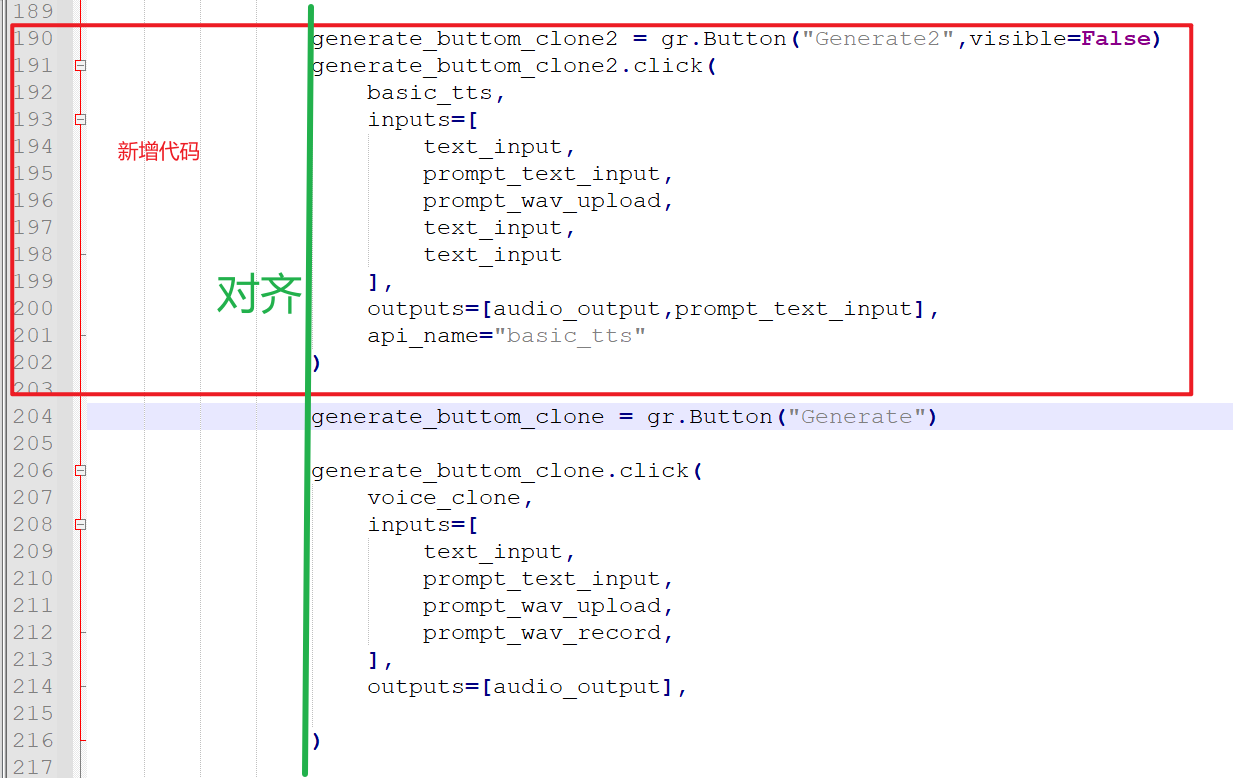
- After saving the file, restart
webui.py:
python webui.py
- Fill in the address
http://127.0.0.1:7860in the API address of "Menu" -> "TTS Settings" -> "F5-TTS" in the pyVideotrans software, and you can start using it. The location and filling method of the reference audio are the same as the usage method of F5-TTS.
